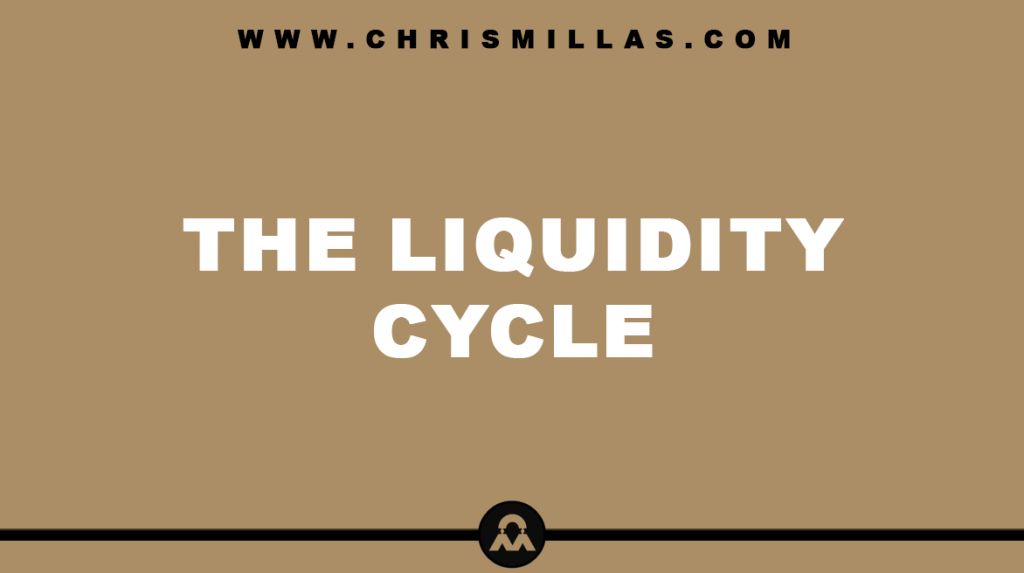In this post, we’ll unpack all you need to know about the liquidity cycle, defining exactly what it is, how it works, how long it lasts and more.
What Is The Liquidity Cycle?
The liquidity cycle (LC) refers to the fluctuation in the availability and cost of money in an economy over time.
What Is Liquidity?
Liquidity is defined as the flow of cash and credit though financial markets.
According to research conducted by Managing Director at CrossBorder Capital Michael Howell, liquidity is the paramount factor in today’s market and the liquidity cycle leads asset markets by 3-9 months.
How Does The Liquidity Cycle Work?
The liquidity cycle works through alternating phases of liquidity expansion and liquidity contraction.
During the expansion phase, low interest rates and easy access to credit encourage more borrowing which drives the economy to grow. This increases asset prices and creates a positive feedback loop. Eventually imbalances arise which lead to the start of the contraction phase.
During the contraction phase, high interest rates and hard access to credit encourage more saving and which drives the economy to shrink. This decreases asset prices and creates a negative feedback loop. Eventually imbalances arise which lead to the start of the expansion phase.
U.S. Liquidity
One way to measure U.S. liquidity (the amount of dollars available to circulate in the U.S. economy) is FED Net Liquidity. This is calculated by taking the size of the FED’s Balance Sheet, minus money sucked out into the Treasury, minus money sucked out into Reverse Repo.
It’s important to note that the size of the FED’s balance sheet doesn’t matter. What matters is the portion of it that’s available to circulate in the economy (aka Net Liquidity).
Net Liquidity (which has a 2 week lead) and the S&P 500 (which has a 2 week lag) have a ~95% correlation. In other words, a change in liquidity predicts the next two week’s change in asset prices with a ~95% accuracy.
How Does The Liquidity Cycle Impact The Economy?
The liquidity cycle impacts various aspects of the economy. These include:
- Interest Rates: Liquidity expansion decreases interest rates. Liquidity contraction increases interest rates.
- Asset Prices: Liquidity expansion increases asset prices. Liquidity contraction decreases asset prices.
- Borrowing: Borrowing increases during liquidity expansion due to lower interest rates and decreases during liquidity contraction due to higher interest rates.
- Saving: Saving decreases during liquidity expansion due to lower interest rates and increases during liquidity contraction due to higher interest rates.
- Economic Growth: The cycle influences overall economic growth by affecting business investments, consumer spending and job creation.
- Investor Sentiment: The cycle shapes investor confidence, risk appetite and decision-making.
These impacts will differ in magnitude and duration based on the specific characteristics of each cycle and the underlying economic conditions.
How Long Do Liquidity Cycles Last?
The liquidity cycle does not have a fixed time frame. Its duration can vary based on factors such as monetary policy, economic conditions, investor sentiment and global events.
Thus, when investing, it is essential for investors to monitor liquidity conditions and be aware of the potential risks and opportunities that arise from changes in the liquidity cycle.
Why Understanding The Liquidity Cycle Is Important
From an investment standpoint, understanding the Liquidity Cycle is essential to making more informed investment decisions and maximising investment profits.
It is essential to understand that timing the market is challenging and some may say should completely be avoided. However, a deep understanding of market cycles can provide investors with a strategic edge.
Summary (TL;DR)
The liquidity cycle refers to the fluctuation in the availability and cost of money in an economy over time. It operates through alternating periods of expansion which encourages more borrowing, driving the economy to grow and contraction which encourages more saving, driving the economy to shrink.
Impacts of the liquidity cycle include interest rates, asset prices, borrowing, saving, economic growth and investor sentiment.
Understanding the mechanics of the liquidity cycle is key to making more informed investment decisions and maximising investment profits.







